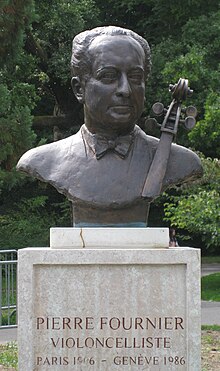
Summary
Francis Poulenc completed his Sonate pour violoncelle et piano (Cello Sonata), FP 143, in 1948. He first sketched it in 1940. It was dedicated to the French cellist Pierre Fournier,[1] who had helped with the technical aspects of the cello part, as the composer was unfamiliar with the instrument.[2] The work was published by Heugel in Paris.
| Sonate pour violoncelle et piano Cello Sonata | |
|---|---|
| Chamber music by Francis Poulenc | |
 Pierre Fournier, the dedicatee and cellist of the premiere | |
| Catalogue | FP 143 |
| Composed | 1940–1948 |
| Dedication | Pierre Fournier |
| Performed | 18 May 1949: Paris |
Genesis edit
When World War II broke out, general mobilization was decreed in France in August 1939. Poulenc was in Noizay and worked on the re-writing of his sextet and the instrumentation of the Cocardes as well as the Fiançailles pour rire.[3] As of June 2, 1940, he was assigned to Bordeaux and noted some musical bars during a short stay in Cahors. From 18 July 1940, he was demobilized after the armistice, joined a friend in Brive-la-Gaillarde[3] and sketched the cello sonata as well as L'Histoire de Babar, le petit éléphant and Les Animaux modèles.[3]
It was not until the aftermath of the war that Poulenc wrote several works including a major one, the Figure humaine cantata, and completed the sonata which was finished after the Calligrammes[4] after the homonymous work by Guillaume Apollinaire at the end of the year 1948. He resumed the draft begun in 1940 at the request of his dedicatee Pierre Fournier[4] and returned to the writing of the sonata, but he was not inspired by writing for the cello, nor for the violin.[4] Besides, his violin sonata was a failure and was judged by some authors weak, even mediocre.[5] Remained in the papers of the composers for several years, the cello sonata was finally completed only in 1948. It was premiered at salle Gaveau in Paris on 18 May 1949[5] by Poulenc as the pianist, and Pierre Fournier, the dedicatee, as the cellist.[6]
Reception and legacy edit
Judged by some "pleasant no more",[4] the posterity of the sonata is stronger than that of the violin sonata, notably because of its superiority.[5] The author Renaud Machart judges the Cavatine severe but beautiful, the Finale "very successful" but deplores the lack of character of the first movement Allegro[5] while the comments of the biographer Henri Hell are more definite and specify that "in spite of a very pretty Cavatine, it has little interest ".[4] This appreciation is shared by Adélaïde de Place Adelaide de Place in the notice that she dedicates to the composer in the Guide de la musique chambre published by Fayard, specifying that the two works that are the violin sonata and that for cello "are not among the best pages of their author".[7]
Style edit
Some authors compare the sonata of Poulenc to the style of Vincent d'Indy or Albéric Magnard.[5] Some of his themes recall Les Animaux modèles, a work the composer completed at the time of the sketches of this sonata.[4]
Structure edit
The sonata is in four movements:[8]
Each movement is in ternary form, having a contrasting middle section. The piece makes much use of Neo-Baroque and Neo-Classical styles.
Selected discography edit
- Pierre Fournier (cello), Jacques Février (piano): Francis Poulenc – Musique de chambre Vol. 1 – EMI
- François Salque (cello), Éric Le Sage (piano) : Francis Poulenc – Intégrale Musique de chambre – RCA Red Seal
- Daniel Müller-Schott (cello), Robert Kulek (piano): Debussy - Poulenc - Franck - Ravel
References edit
- ^ Libbey, T. (2006). The NPR Listener's Encyclopedia of Classical Music. Workman Publishing Company. p. 240. ISBN 978-0-7611-2072-8.
- ^ Prieto, Carlos; Murray, Elena C.; Mutis, Alvaro (FRW), "The adventures of a cello", p. 263, University of Texas Press, 2006 ISBN 0-292-71322-3, ISBN 978-0-292-71322-2
- ^ a b c Schmidt 1995, p. 165
- ^ a b c d e f Schmidt 1995, p. 214
- ^ a b c d e Schmidt 1995, p. 161
- ^ Notice of the record Francis Poulenc – Intégrale Musique de chambre – RCA Red Seal, p. 7
- ^ de Place 1989, p. 704
- ^ Schmidt 1995, p. 393.
Bibliography edit
- Schmidt, Carl B. (1995). The Music of Francis Poulenc (1899–1963): A Catalogue (in French). Oxford: Clarendon Press. ISBN 978-0-19-158516-6.
- de Place, Adélaïde (1989). "Francis Poulenc". In Tranchefort, François-René (ed.). Guide de la musique de chambre. Paris: Fayard. ISBN 9782213024035.
External links edit
- Cello Sonata (Poulenc): Scores at the International Music Score Library Project
- Cello Sonata at AllMusic


